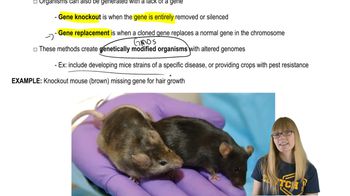Which of the following proteins is an example of a tumor suppressor?
Table of contents
- 1. Introduction to Genetics51m
- 2. Mendel's Laws of Inheritance3h 37m
- 3. Extensions to Mendelian Inheritance2h 41m
- 4. Genetic Mapping and Linkage2h 28m
- 5. Genetics of Bacteria and Viruses1h 21m
- 6. Chromosomal Variation1h 48m
- 7. DNA and Chromosome Structure56m
- 8. DNA Replication1h 10m
- 9. Mitosis and Meiosis1h 34m
- 10. Transcription1h 0m
- 11. Translation58m
- 12. Gene Regulation in Prokaryotes1h 19m
- 13. Gene Regulation in Eukaryotes44m
- 14. Genetic Control of Development44m
- 15. Genomes and Genomics1h 50m
- 16. Transposable Elements47m
- 17. Mutation, Repair, and Recombination1h 6m
- 18. Molecular Genetic Tools19m
- 19. Cancer Genetics29m
- 20. Quantitative Genetics1h 26m
- 21. Population Genetics50m
- 22. Evolutionary Genetics29m
19. Cancer Genetics
Cancer Mutations
Problem C.6b
Textbook Question
Radiation is frequently used as part of the treatment of cancer. The radiation works by damaging DNA and components of the cell. Is there a risk of damage to noncancer cells?
 Verified step by step guidance
Verified step by step guidance1
Understand that radiation therapy targets rapidly dividing cancer cells by damaging their DNA, which prevents them from replicating and surviving.
Recognize that noncancerous (normal) cells in the vicinity of the treatment area can also be exposed to radiation, as the radiation is not perfectly selective.
Consider that DNA damage in noncancer cells can lead to cell death or mutations, which may cause side effects or long-term risks such as secondary cancers.
Explore the concept of differential sensitivity, where some normal cells may be more resistant or able to repair DNA damage better than cancer cells, influencing the extent of risk.
Conclude that while radiation therapy aims to minimize harm to normal cells, there is an inherent risk of damage to noncancer cells due to the nature of radiation exposure.
 Verified video answer for a similar problem:
Verified video answer for a similar problem:This video solution was recommended by our tutors as helpful for the problem above
Video duration:
2mPlay a video:
Was this helpful?
Key Concepts
Here are the essential concepts you must grasp in order to answer the question correctly.
Mechanism of Radiation Therapy
Radiation therapy uses high-energy radiation to damage the DNA of cancer cells, preventing their replication and leading to cell death. It targets rapidly dividing cells but can also affect other cells in the treatment area.
Recommended video:
Guided course

Transgenic Organisms and Gene Therapy
DNA Damage and Repair
Radiation causes breaks and mutations in DNA strands. While cancer cells often have impaired repair mechanisms, normal cells can sometimes repair this damage, but excessive damage may lead to cell death or mutations.
Recommended video:
Guided course

Repair Pathways
Effects on Noncancerous Cells
Noncancerous cells near the radiation site can also be damaged because radiation is not perfectly selective. This can cause side effects and risks, as healthy tissue may be harmed during treatment.
Recommended video:
Guided course

Maternal Effect
Related Videos
Related Practice
Multiple Choice
521
views
1
rank


